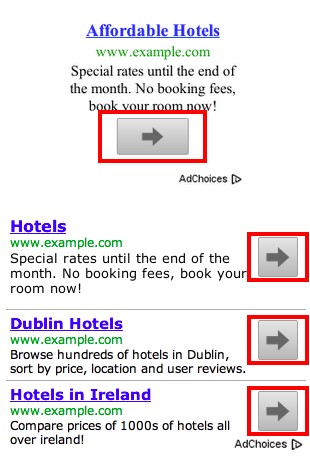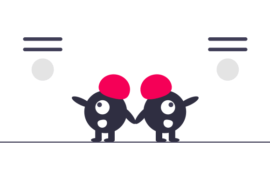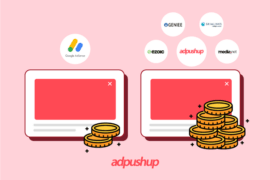There’s a major concern in the Google AdSense community nowadays and it all started when these arrows were found missing their usual spot.

First Sighting of the Nessie Arrows
Back in late 2012, Google had implemented these arrows next to their text ads in what was dubbed as the biggest makeover in AdSense. These arrows, fondly referred to as “Nessie Arrows”, were placed by Google in order to aid users with “fat fingers”, to help click their ads if they were using mobile devices such as smartphones and tablets.
Later on, these arrows were also implemented on desktop text ads on the Google Display Network. Ad publishers saw significant benefits with the Nessie arrows, as their AdSense RPM increased in numbers.
However, in early 2013, there was a small percentage (about 5000 in number) of AdSense publishers who claimed that their Nessie arrows had gone missing, resulting into big drops in revenues and CTRs.
Google AdSense FAQ on Nessie Arrows
One of those 5000 publishers decided to contact AdSense Support and got this Q&A that should be applicable to today’s predicament:
On Friday 9th, a change went out that removed the arrow button (Nessie) from the text ads appearing on about ~5000 publishers websites. These publishers possibly intentionally or unintentionally have ad implementations that mislead users as measured by the rate of accidental clicks.
For these publishers we will continue to serve ads but we have removed the arrow button. These changes are meant to optimize the experience for advertisers, publishers and users alike. Some of these publishers may see fluctuations in their CPCs, CTRs and/or RPMs from smart pricing due to these implementations.
We have put together this FAQ:
Q. Why is the button no longer on my website? Why was the button removed from all the pages of my website?
A. Our systems have determined that some ad elements in text ads implemented on your site are not performing well for users, advertisers, and/or the publish network, therefore, the arrow button may not display on your ads moving forward. Different ad elements may or may not appear in text ads depending on what is deemed best performing for users, advertisers, and publishers. We believe these changes will encourage advertisers to spend more on the network, and lift earnings for our publisher clients in the long term.
Q. Why has my CTR gone down?
A. Clicks/CTR are largely a factor of ad type, ad rendering and ad placement amongst others. Depending on the performance of an ad unit we may change how ads are rendered to prevent accidental clicks. You may want to check your ad implementations as they may be causing users to take unintended actions. Please see How you can help to prevent invalid activity for more.
Q. Why has my CPC gone down? Why has my Revenue/RPM gone down?
A. Many factors determine the performance of an ad including CTR, CPC, user intent, advertiser ROI, and others. While we can’t draw specific conclusions about your site, in general our algorithms are designed to optimize and reflect the value users and advertisers are receiving from specific ad placements.
Q. Can I do anything specific to get the button text back?
A. No. While we can’t draw specific conclusions about your site, in general our algorithms are designed to optimize and reflect the value users and advertisers are receiving from specific ad placements. This can change over time and may or may not include additional ad elements like the clickable button.
Key Takeaways from the Nessie Update
Fast forward to 2016. The same problem is happening again. What would be our key takeaways based from these answers from Google?
- The Nessie arrow may or may not reappear for sometime: If you were to visit the original post, there were specific questions that were answered vaguely by Google’s AdSense Team.
- Users cannot fix this issue themselves: Google AdSense Team cannot and probably will not inform anyone on how to get those arrows back, and it’s forbidden to mess around with the AdSense code. So do not attempt to place arrows on these ad units by yourself!
- This is not a location-specific occurrence: This is happening on a global scale; Google is not targeting any specific area. Users from the US and the UK were reporting discrepancies in their revenues due to Nessie’s disappearance.
- Google may just be removing them for good: Technically, Google’s overhaul on Nessie arrows backfired as these arrows were primarily confused by users as navigation buttons.
- Google’s AI is profoundly intelligent: It can detect aggressive placement of ads, especially if you’re really “baiting” these ads to look like navigation buttons for paginated content.
Post Nessie Era: What Can You Do
With the uncertainty brought about by Nessie arrow’s on and off disappearance, what can we do as publishers?
Change the ad layout of your website: Avoid obvious blunders. It has been widely suggested that making sure that the ad units are not too close to the “navigational” buttons works for many publishers. They got their arrows back after around a week’s worth of waiting.
Add “Sponsored Links” to your ads: This was one of the recommendations made by a Google AdSense Representative to one publisher. User Maximum44 got in touch with a representative and was told to add “sponsored links” in all ad positions that were prone to accidental clicks.

Change your ad network: You can do this if the drop in Google AdSense revenue is unacceptable to you. A popular option among ad publishers is migrating to Media.net and other ad networks that haven’t imposed this rule at the moment.
Choose an A/B testing solution: While an A/B testing solution such as AdPushup may not be able to get your arrows back, it will help you generate more revenue which can help you make up for the losses you suffer elsewhere because of factors such as sudden policy changes and banner blindness.
Priyesh, Product Evangelist at AdPushup, shares the steps he took to get the Nessie arrows back when a client publisher lost them:
Publishers must be very careful in implementing ads, especially, close to navigation/pagination buttons. The crux idea behind staying policy-compliant is to prevent any accidental or unintended clicks from users. The intent is very important.
We have had a similar case in the past, wherein a publisher had implemented ads too close to navigation buttons. The arrow buttons from text ads disappeared and the CTR of the website fell down by close to 37%.
We worked with the publisher, helping him change the ad layout, making it compliant by having enough spacing between the ad and the clickable button, apart from adding proper labelling in ads. Within two weeks, the arrow buttons were back and the CTR increased gradually.
Where the Nessie Arrow is Headed
The disappearance of these arrows should be regularly anticipated as Google is known for implementing UX-based regulations whether for search engines or ad networks. If there’s something that we should learn from this experience, it’s that we should be able to adapt to these changes, and work out different solutions to make up for the loss.
As of now, these arrows come back and forth depending mostly on your ad layout. This seems to be a quick fix, but there’s no telling what’s in store in the future.
Author caveat: Take note that these various approaches worked for some, while others claimed that these solutions didn’t help them regain their precious arrows back.
This is a guest contribution by John Stevens, a WordPress and design enthusiast. He loves to code websites, make them visually appealing, and improving their user experience. When he’s not grooming his beard, John is working hard to get more visibility and traffic to Hosting Facts, home to unbiased web hosting reviews.
A growth blog for professional bloggers and ad ops professionals.







